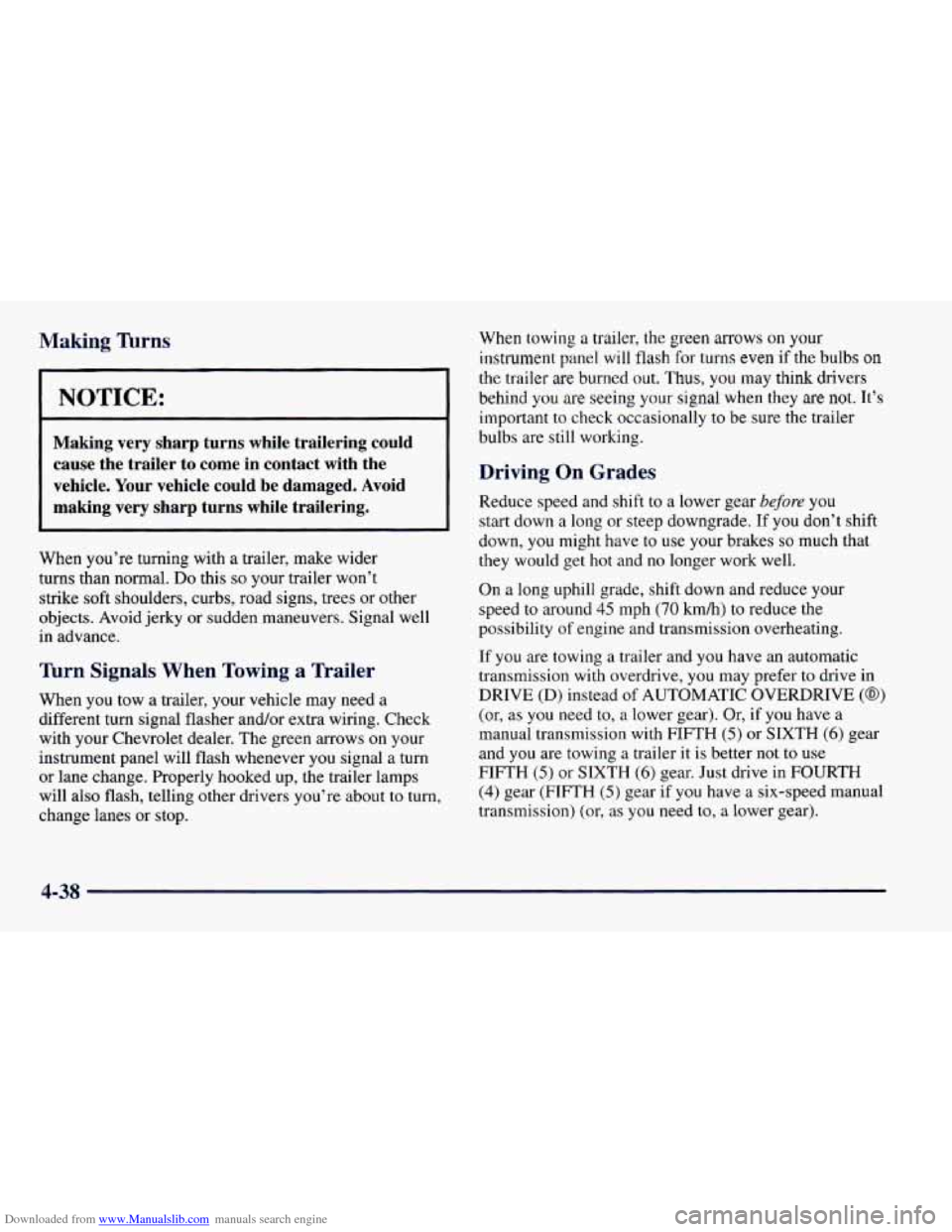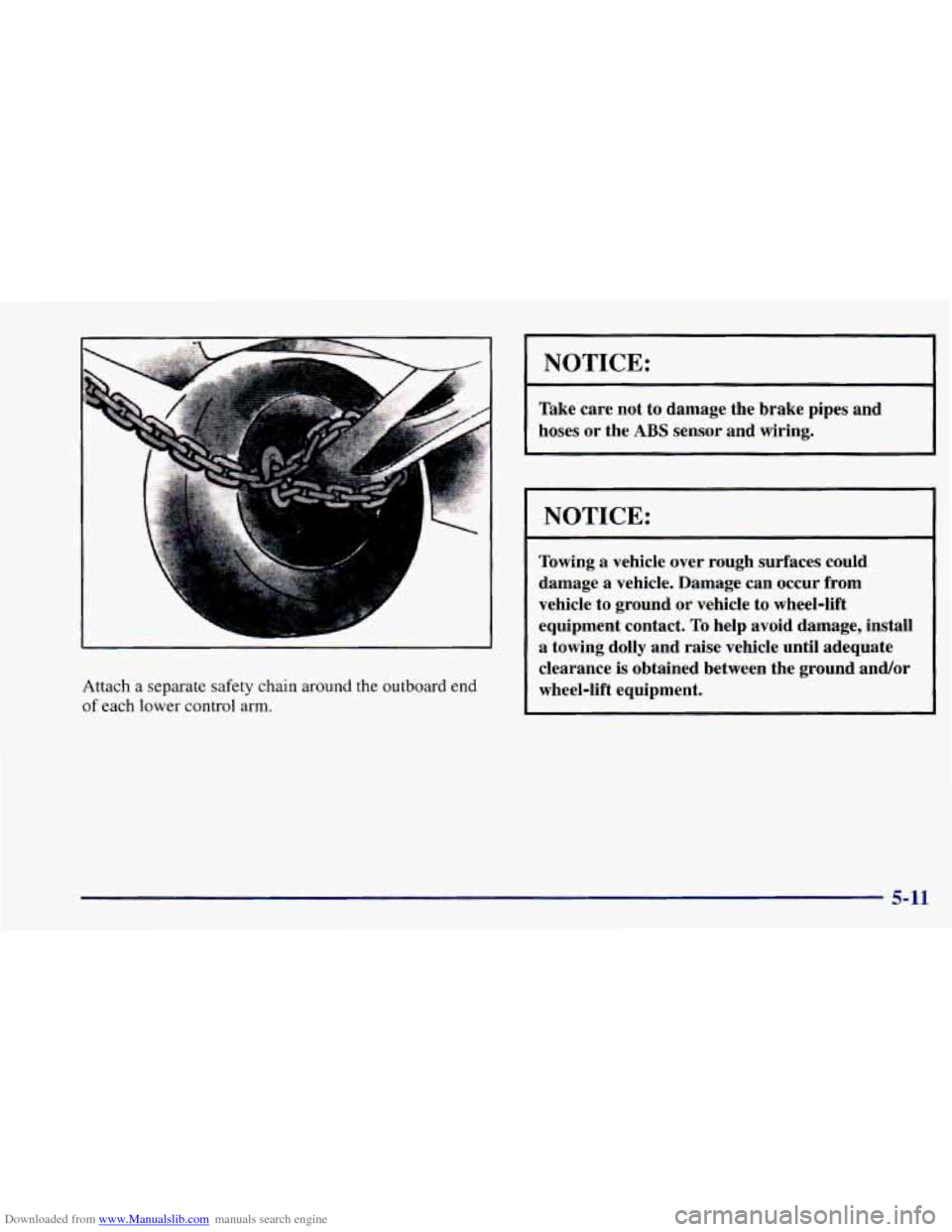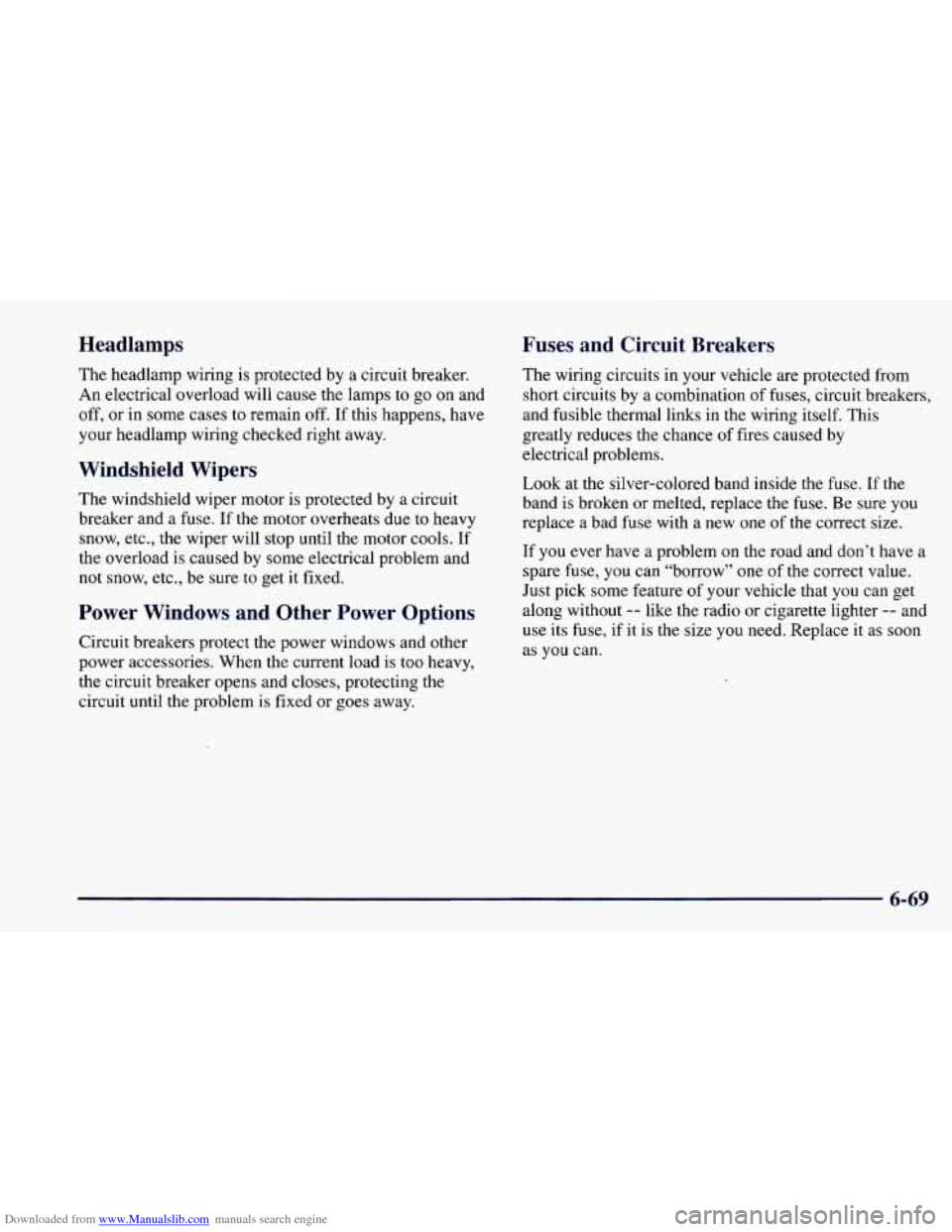1997 CHEVROLET CAMARO wiring
[x] Cancel search: wiringPage 61 of 404

Downloaded from www.Manualslib.com manuals search engine NOTICE:
When replacing the battery, use care not to touch
any
of the circuitry. Static from your body
transferred to these surfaces may damage
the transmitter.
To replace the battery in the Remote Keyless
Entry transmitter:
1.
2.
3.
4.
5.
Carefully pry off the cover by inserting a dime (or
similar object) in a slot between the covers and twist.
Lift
off the back cover.
Remove and replace the battery. Use one battery,
type CR2032, or a similar type. Put the new battery
in, printed side down.
Replace the front cover. Make sure the cover is on
tightly
so water won’t get in.
Check the transmitter operation. If the transmitter
does not work after battery replacement, it may need
to be resynchronized
or matched to your vehicle. See
“Resychronization” in the Index.
N:
It can be dangerous to drive with the hatch open
because carbon monoxide (CO) gas can come into
your vehicle. You can’t see or smell CO.
It can
cause unconsciousness and even death.
If you must drive with the hatch open or if
electrical wiring or other cable connections
must pass through the seal between the body and
the hatch:
Make sure all windows are shut.
Thrn the fan on your heating or cooling
system to
its highest speed with the setting
on VENT. That will force outside
air into
your vehicle. See “Comfort Controls” in
the Index.
instrument panel, open them all the
way.
If you have air outlets on or under the
See “Engine Exhaust” in the Index.
2-11
Page 128 of 404

Downloaded from www.Manualslib.com manuals search engine Safety Belt Reminder Light
When the key is turned to RUN or START, a chime will
come on for about eight seconds to remind people to
fasten their safety belts.
The safety belt light will
also come on and stay on
for about
70 seconds. If the
driver’s belt is already
buckled, neither the chime
nor the light will come
on.
Air Bag Readiness Light
There is an air bag readiness light on the instrument
panel, which shows
AIR BAG. The system checks the
air bag’s electrical system for malfunctions. The light
tells you if there is an electrical problem. The system
check includes the air bag sensors, the air bag modules, the wiring and the
crash sensing and diagnostic module.
For more information on the air bag system, see “Air
Bag” in the Index.
AIR
BAG
This light will come on
when you start your engine,
and it will flash for
a few
seconds. Then the light
should go out. This means
the system is ready.
If the air bag readiness light stays on after you start the
engine or comes
on when you are driving, your air bag
system may not work properly. Have your vehicle
serviced right away.
The air bag readiness light should flash for a few
seconds when you turn the ignition key to
RUN. If the
light doesn’t come on then, have
it fixed so it will be
ready to warn you if there is a problem.
2-78
Page 202 of 404

Downloaded from www.Manualslib.com manuals search engine Making firns
I NOTICE:
Making very sharp turns while trailering could cause the trailer to come in contact with the
vehicle. Your vehicle could be damaged. Avoid
making very sharp turns while trailering.
When you’re turning with a trailer, make wider
turns than normal.
Do this so your trailer won’t
strike soft shoulders, curbs, road signs, trees or other
objects. Avoid jerky or sudden maneuvers. Signal well
in advance.
%rn Signals When Towing a Trailer
When you tow a trailer, your vehicle may need a
different turn signal flasher and/or extra wiring. Check
with your Chevrolet dealer. The green arrows
on your
instrument panel will flash whenever
you signal a turn
or lane change. Properly hooked up, the trailer lamps
will also flash, telling other drivers you’re about to turn,
change lanes or stop. When
towing
a trailer, the green arrows on your
instrument panel will flash for turns even if the bulbs on
the trailer are burned out. Thus, you may think drivers
behind
you are seeing your signal when they are not. It’s
important
to check occasionally to be sure the trailer
bulbs are still working.
Driving On Grades
Reduce speed and shift to a lower gear before you
start down a long or steep downgrade. If you don’t shift
down, you might have to
use your brakes so much that
they would get hot and no longer work well.
On a long uphill grade, shift down and reduce your
speed
to around 45 mph (70 km/h) to reduce the
possibility of engine and transmission overheating.
If
you are towing a trailer and you have an automatic
transmission with overdrive,
you may prefer to drive in
DRIVE
(D) instead of AUTOMATIC OVERDRIVE (@)
(or, as you need to, a lower gear). Or, if you have a
manual transmission with FIFTH (5) or SIXTH (6) gear
and
you are towing a trailer it is better not to use
FIFTH
(5) or SIXTH (6) gear. Just drive in FOURTH
(4) gear (FIFTH (5) gear if you have a six-speed manual
transmission) (or, as
you need to, a lower gear).
4-38
Page 215 of 404

Downloaded from www.Manualslib.com manuals search engine Attach a separate safety chain around the outboard end
of each lower control arm.
NOTICE: I
Take care not to damage the brake pipes and
hoses
or the ABS sensor and wiring.
NOTICE:
Towing a vehicle over rough surfaces could
damage a vehicle, Damage can occur from
vehicle to ground or vehicle to wheel-lift
equipment contact,
To help avoid damage, install
a towing dolly and raise vehicle until adequate
clearance
is obtained between the ground and/or
wheel-lift equipment.
5-11
Page 289 of 404

Downloaded from www.Manualslib.com manuals search engine Headlamps
Before replacing a headlamp that does not light, check
to make sure that the wiring connector is securely
fastened to it.
See “Replacement Bulbs” in the Index to check the size
and type
of headlamp you need to use before you begin
to replace the headlamp. You must replace a headlamp
with
one that is exactly the same.
Be careful not to move the aiming screws when you
replace the headlamp.
If the headlamp being replaced
was properly aimed, the new one will be also if it
is
properly installed.
1. Remove the Tom@ head screws at the end of the
aiming ring.
6-43
Page 290 of 404

Downloaded from www.Manualslib.com manuals search engine 2. The aiming ring will swing open like a gate. Remove
the aiming ring from the assembly. Place it face
down, with the aim indicator up.
Be careful not to
damage the aiming bubble.
3. Pull the headlamp out of the assembly. Remove the
wiring connector from the headlamp socket by lifting
the plastic locking tabs on the connector and pulling
it from the socket.
6-44
Page 291 of 404

Downloaded from www.Manualslib.com manuals search engine 4. Check the new headlamp again. The number on the
lamp must match the number
of the headlamp being
replaced. The letter
U or L must also match.
5. Plug the wiring connector into the headlamp socket.
6. Place the new headlamp in the headlamp assembly.
Snap
the locking tabs onto the socket.
The socket must be pointing in the same direction
the socket
on the burned out bulb was.
7. Insert the tabs on the aiming ring into the tabs in the
8. Hold the aiming ring closed, insert the screws at the
end
of the ring. Tighten the screws until the aiming
ring touches the plastic nuts on both the top and
bottom.
Do not overtighten. Do not damage the
vertical aiming bubble.
headlamp assembly. 9. Check the
headlamp aim indicators. The horizontal
indicator
(A) should be on 0 (zero). If the vehicle is
level, the vertical indicator
(B) should also be on
0 (zero). If the vehicle isn’t level, check the vertical
aim on a level surface as soon as you can.
If either
indicator doesn’t read
0 (zero), adjust the headlamp
aim. See “Adjusting Headlamp Aim’’ in the Index.
If your vehicle is damaged in an accident and the
headlamp aim seems to be affected, see your
Chevrolet dealer. Headlamps on damaged vehicles may
require recalibration of the horizontal aim by your
Chevrolet dealer.
6-45
Page 315 of 404

Downloaded from www.Manualslib.com manuals search engine Headlamps Fuses and Circuit Breakers
The headlamp wiring is protected by a circuit breaker.
An electrical overload will cause the lamps to go on and
off, or in some cases to remain off.
If this happens, have
your headlamp wiring checked right away.
Windshield Wipers
The windshield wiper motor is protected by a circuit
breaker and a
fuse. If the motor overheats due to heavy
snow, etc., the wiper will stop until the motor cools.
If
the overload is caused by some electrical problem and
not snow, etc.,
be sure to get it fixed.
Power Windows and Other Power Options
Circuit breakers protect the power windows and other
power accessories. When the current load is too heavy,
the circuit breaker opens and closes, protecting the
circuit until the problem is fixed or goes away. The
wiring circuits in your vehicle are protected from
short circuits by a combination of fuses, circuit breakers,
and fusible thermal links in the wiring itself. This
greatly reduces the chance of fires caused by
electrical problems.
Look at the silver-colored band inside the fuse.
If the
band is broken or melted, replace the
fuse. Be sure you
replace a bad fuse with a new one of the correct size.
If you ever have a problem on the road and don’t have a
spare fuse, you can “borrow”
one of the correct value.
Just pick some feature of your vehicle that you can get
along without
-- like the radio or cigarette lighter -- and
use its fuse, if it is the size you need. Replace it as soon
as you can.
6-69